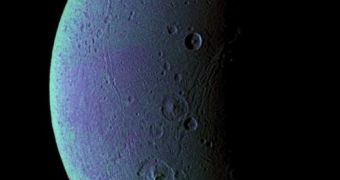A new investigation conducted with the NASA Cassini orbiter revealed the existence of molecular oxygen in the atmosphere surrounding the Saturnine moon Dione. This chemical is absolutely essential for making air on Earth breathable, and able to support complex life
The spacecraft did not identify quantities large enough to make researchers suspect that the moon may be able to support life, but the investigation did demonstrate that it's possible for objects such as this one to host such chemicals.
One of the things separating Dione from many of the other moons orbiting Saturn (with the notable exceptions of Enceladus and Rhea) is the fact that it's covered in ice. Scientists suspect that this may be one of the sources for the molecular oxygen ions Cassini was able to discover recently.
It's very important to remember that Dione has only a very tenuous atmosphere, which is significantly less dense than Earth's. Its properties are very similar to that of our atmospheres, but at an altitude of about 300 miles (480 kilometers) above the surface.
According to the Cassini datasets, the molecular oxygen ions do not exist in high concentrations. The probe identified one in every 0.67 cubic inches [11 cubic centimeters] of space, which is rather sparse.
This is the equivalent of about 90,000 such ions per cubic meter (2,550 ions per cubic foot). What this suggests is that the neutral atmosphere around Dione is extremely thin. The correct technical term for this gaseous layer is an exosphere. Our Moon is surrounded by an exosphere as well.
Details of the new Cassini study were published in a recent issue of the esteemed scientific journal Geophysical Research Letters. Experts believe that some of these ions are produced when space radiations or highly-energetic photons from the Sun impact the ice layers covering Dione.
“We now know that Dione, in addition to Saturn's rings and the moon Rhea, is a source of oxygen molecules. This shows that molecular oxygen is actually common in the Saturn system and reinforces that it can come from a process that doesn't involve life,” scientist Robert Tokar explains.
The expert, a member of the Cassini science team, holds an appointment as a researcher at the Los Alamos, New Mexico-based DOE Los Alamos National Laboratory (LANL). He was also the lead author of the GRL paper.
Some scientists believe that the oxygen ions may have a geological source. Future investigations will attempt to focus on this idea, but the particle bombardment theory makes more sense even now.
“Scientists weren't even sure Dione would be big enough to hang on to an exosphere, but this new research shows that Dione is even more interesting than we previously thought,” Amanda Hendrix says.
“Scientists are now digging through Cassini data on Dione to look at this moon in more detail,” concludes the expert, who holds an appointment as a Cassini deputy project scientist at the NASA Jet Propulsion Laboratory (JPL), Pasadena. She was not a part of the study team.

 14 DAY TRIAL //
14 DAY TRIAL //